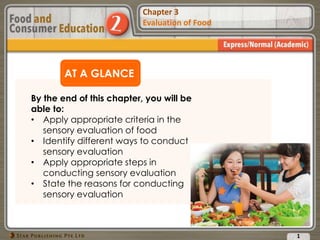
Chapter 3 Evaluation of Food
- 1. Chapter 2 Food Presentation Chapter 3 Evaluation of Food AT A GLANCE By the end of this chapter, you will be able to: • Apply appropriate criteria in the sensory evaluation of food • Identify different ways to conduct sensory evaluation • Apply appropriate steps in conducting sensory evaluation • State the reasons for conducting sensory evaluation 1
- 2. Chapter 2 Food Presentation Chapter 3 Evaluation of Food • Sensory evaluation is the evaluation of the sensory properties of food (appearance, flavour, texture) • It can be carried out by the following steps: 1. look at the food and describe the overall appearance 2. smell the food and describe its aroma 3. cut the food and feel its texture 4. chew the food and describe the taste and mouthfeel 2 Introducing sensory evaluation
- 3. Chapter 2 Food Presentation Chapter 3 Evaluation of Food 3 Sensory properties of food Appearance • Involves the sense of sight • Can be described in terms of colour, size, shape, consistency and crumb • Example: golden brown, small, round, smooth, coarse
- 4. Chapter 2 Food Presentation Chapter 3 Evaluation of Food 4 Sensory properties of food Texture • Involves the senses of sight and touch • Mouthfeel is the sensation when we bite and chew food • Different cooking methods produce different textures • Example: soft, chewy, crispy, sticky, grainy
- 5. Chapter 2 Food Presentation Chapter 3 Evaluation of Food 5 Sensory properties of food Flavour • Flavour is produced by a combination of taste and aroma • Taste – The taste buds on our tongue enable us to detect the different tastes of food – Example: sweet, spicy, bland, buttery, nutty • Aroma – Involves the sense of smell – Detected by the nose – Example: fragrant, burnt, floral, fishy, fruity
- 6. Chapter 2 Food Presentation Chapter 3 Evaluation of Food 6 Types of Sensory Tests Ranking test • Ranking of food samples according to a specific property e.g. sweetness • Ranking of food samples according to the tester’s preference to find out the popularity of each food sample Sample code Ranking order 315 2 837 1 642 3 315 642837
- 7. Chapter 2 Food Presentation Chapter 3 Evaluation of Food 7 Types of Sensory Tests Rating test • Rating of food samples according to a scale to find out the degree of preference for each food sample Sample code Degree of preference 315 5 837 3 642 4315 642837 1 – dislike a lot 2 – dislike moderately 3 – neutral 4 – like moderately 5 – like a lot
- 8. Chapter 2 Food Presentation Chapter 3 Evaluation of Food 8 Types of Sensory Tests Triangle test • Three samples are given where one of the samples is different from the rest. Tester is asked to identify the odd sample • Used to find out if the difference between two similar samples can be detected 315 642837 Sample code 642 Reason(s) This sample is sweeter
- 9. Chapter 2 Food Presentation Chapter 3 Evaluation of Food 9 Conducting Sensory Tests • Sensory tests should be conducted in a fair and accurate manner • You can follow the steps below when conducting a sensory test: Decide on the test to use1 Select the testers based on the requirements of the test 2
- 10. Chapter 2 Food Presentation Chapter 3 Evaluation of Food 10 Conducting Sensory Tests Prepare the response sheets • Give clear instructions • Leave enough space for testers to write their responses 3 Prepare the food samples • Label samples with code numbers • Serve samples at the same amounts and under the same conditions 4 Provide proper conditions for testing • Explain the test procedures to testers • Provide testing booths to separate testers • Provide a glass of water to clear the taste after each sampling 5
- 11. Chapter 2 Food Presentation Chapter 3 Evaluation of Food 11 Conducting Sensory Tests Conduct the test • Make sure the test area is quiet • Give testers enough time to taste each sample • Do not allow testers to communicate with each other 6 Gather results and draw conclusions • Collect the test results • Use tables, pie charts, graphs or star diagrams to present your findings 7 Plan further actions • Make decisions based on the results of the sensory test 8
- 12. Chapter 2 Food Presentation Chapter 3 Evaluation of Food 12 Presenting Test Results • Table • Pie chart
- 13. Chapter 2 Food Presentation Chapter 3 Evaluation of Food 13 Presenting Test Results • Graph • Radar chart
- 14. Chapter 2 Food Presentation Chapter 3 Evaluation of Food 14 Presenting Test Results Radar chart • Describes the intensity of the sensory properties of food samples by marking the scores on the axes • Used to compare the sensory properties of two or more food samples
- 15. Chapter 2 Food Presentation Chapter 3 Evaluation of Food 15 Reasons for Sensory Evaluation In the food industry, sensory evaluation is conducted to: • Check if the food product meets the standard and remains consistent across different batches • Improve on the quality by modifying the recipe • Determine consumers’ acceptance and preference • Compare similar food products • Investigate specific features of an ingredient or food product, e.g. the texture of noodles